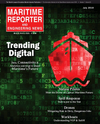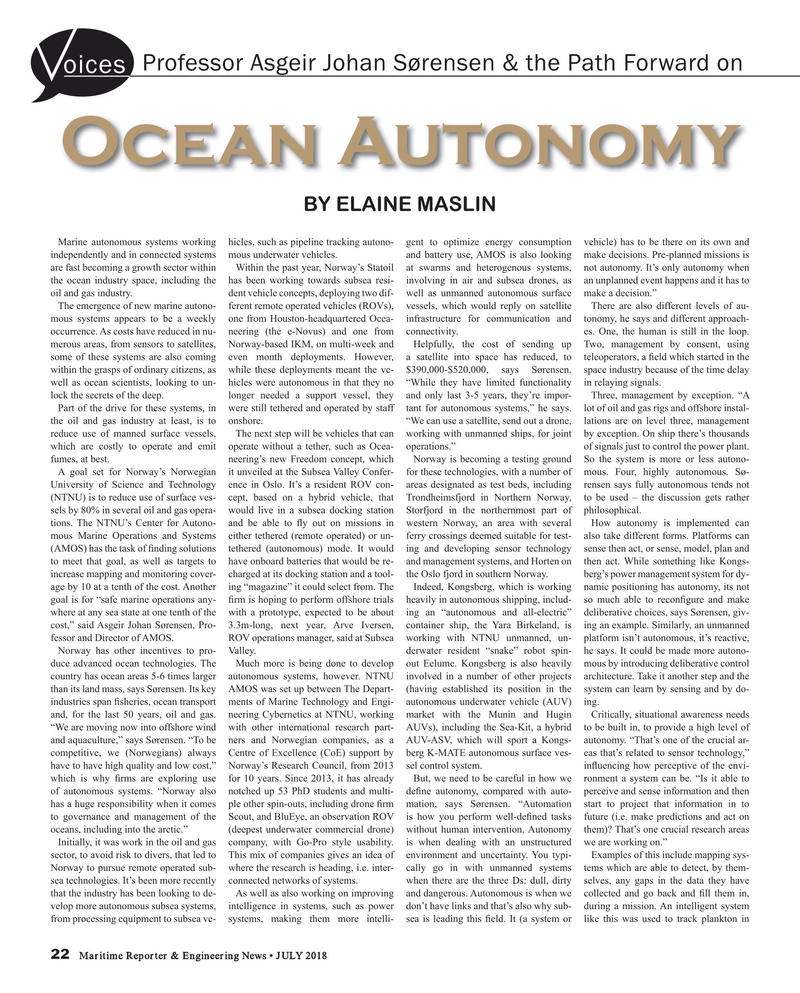
Page 22: of Maritime Reporter Magazine (July 2018)
Marine Communications Edition
Read this page in Pdf, Flash or Html5 edition of July 2018 Maritime Reporter Magazine
Professor Asgeir Johan Sørensen & the Path Forward on oices
BY ELAINE MASLIN
Marine autonomous systems working hicles, such as pipeline tracking autono- gent to optimize energy consumption vehicle) has to be there on its own and independently and in connected systems mous underwater vehicles. and battery use, AMOS is also looking make decisions. Pre-planned missions is are fast becoming a growth sector within Within the past year, Norway’s Statoil at swarms and heterogenous systems, not autonomy. It’s only autonomy when the ocean industry space, including the has been working towards subsea resi- involving in air and subsea drones, as an unplanned event happens and it has to oil and gas industry. dent vehicle concepts, deploying two dif- well as unmanned autonomous surface make a decision.”
The emergence of new marine autono- ferent remote operated vehicles (ROVs), vessels, which would reply on satellite There are also different levels of au- mous systems appears to be a weekly one from Houston-headquartered Ocea- infrastructure for communication and tonomy, he says and different approach- occurrence. As costs have reduced in nu- neering (the e-Novus) and one from connectivity. es. One, the human is still in the loop. merous areas, from sensors to satellites, Norway-based IKM, on multi-week and Helpfully, the cost of sending up Two, management by consent, using some of these systems are also coming even month deployments. However, a satellite into space has reduced, to teleoperators, a ? eld which started in the within the grasps of ordinary citizens, as while these deployments meant the ve- $390,000-$520,000, says Sørensen. space industry because of the time delay well as ocean scientists, looking to un- hicles were autonomous in that they no “While they have limited functionality in relaying signals. lock the secrets of the deep. longer needed a support vessel, they and only last 3-5 years, they’re impor- Three, management by exception. “A
Part of the drive for these systems, in were still tethered and operated by staff tant for autonomous systems,” he says. lot of oil and gas rigs and offshore instal- the oil and gas industry at least, is to onshore. “We can use a satellite, send out a drone, lations are on level three, management reduce use of manned surface vessels, The next step will be vehicles that can working with unmanned ships, for joint by exception. On ship there’s thousands which are costly to operate and emit operate without a tether, such as Ocea- operations.” of signals just to control the power plant. fumes, at best. neering’s new Freedom concept, which Norway is becoming a testing ground So the system is more or less autono-
A goal set for Norway’s Norwegian it unveiled at the Subsea Valley Confer- for these technologies, with a number of mous. Four, highly autonomous. Sø-
University of Science and Technology ence in Oslo. It’s a resident ROV con- areas designated as test beds, including rensen says fully autonomous tends not (NTNU) is to reduce use of surface ves- cept, based on a hybrid vehicle, that Trondheimsfjord in Northern Norway, to be used – the discussion gets rather sels by 80% in several oil and gas opera- would live in a subsea docking station Storfjord in the northernmost part of philosophical. tions. The NTNU’s Center for Autono- and be able to ? y out on missions in western Norway, an area with several How autonomy is implemented can mous Marine Operations and Systems either tethered (remote operated) or un- ferry crossings deemed suitable for test- also take different forms. Platforms can (AMOS) has the task of ? nding solutions tethered (autonomous) mode. It would ing and developing sensor technology sense then act, or sense, model, plan and to meet that goal, as well as targets to have onboard batteries that would be re- and management systems, and Horten on then act. While something like Kongs- increase mapping and monitoring cover- charged at its docking station and a tool- the Oslo fjord in southern Norway. berg’s power management system for dy- age by 10 at a tenth of the cost. Another ing “magazine” it could select from. The Indeed, Kongsberg, which is working namic positioning has autonomy, its not goal is for “safe marine operations any- ? rm is hoping to perform offshore trials heavily in autonomous shipping, includ- so much able to recon? gure and make where at any sea state at one tenth of the with a prototype, expected to be about ing an “autonomous and all-electric” deliberative choices, says Sørensen, giv- cost,” said Asgeir Johan Sørensen, Pro- 3.3m-long, next year, Arve Iversen, container ship, the Yara Birkeland, is ing an example. Similarly, an unmanned fessor and Director of AMOS. ROV operations manager, said at Subsea working with NTNU unmanned, un- platform isn’t autonomous, it’s reactive,
Norway has other incentives to pro- Valley. derwater resident “snake” robot spin- he says. It could be made more autono- duce advanced ocean technologies. The Much more is being done to develop out Eelume. Kongsberg is also heavily mous by introducing deliberative control country has ocean areas 5-6 times larger autonomous systems, however. NTNU involved in a number of other projects architecture. Take it another step and the than its land mass, says Sørensen. Its key AMOS was set up between The Depart- (having established its position in the system can learn by sensing and by do- industries span ? sheries, ocean transport ments of Marine Technology and Engi- autonomous underwater vehicle (AUV) ing. and, for the last 50 years, oil and gas. neering Cybernetics at NTNU, working market with the Munin and Hugin Critically, situational awareness needs “We are moving now into offshore wind with other international research part- AUVs), including the Sea-Kit, a hybrid to be built in, to provide a high level of and aquaculture,” says Sørensen. “To be ners and Norwegian companies, as a AUV-ASV, which will sport a Kongs- autonomy. “That’s one of the crucial ar- competitive, we (Norwegians) always Centre of Excellence (CoE) support by berg K-MATE autonomous surface ves- eas that’s related to sensor technology,” have to have high quality and low cost,” Norway’s Research Council, from 2013 sel control system. in? uencing how perceptive of the envi- which is why ? rms are exploring use for 10 years. Since 2013, it has already But, we need to be careful in how we ronment a system can be. “Is it able to of autonomous systems. “Norway also notched up 53 PhD students and multi- de? ne autonomy, compared with auto- perceive and sense information and then has a huge responsibility when it comes ple other spin-outs, including drone ? rm mation, says Sørensen. “Automation start to project that information in to to governance and management of the Scout, and BluEye, an observation ROV is how you perform well-de? ned tasks future (i.e. make predictions and act on oceans, including into the arctic.” (deepest underwater commercial drone) without human intervention. Autonomy them)? That’s one crucial research areas
Initially, it was work in the oil and gas company, with Go-Pro style usability. is when dealing with an unstructured we are working on.” sector, to avoid risk to divers, that led to This mix of companies gives an idea of environment and uncertainty. You typi- Examples of this include mapping sys-
Norway to pursue remote operated sub- where the research is heading, i.e. inter- cally go in with unmanned systems tems which are able to detect, by them- sea technologies. It’s been more recently connected networks of systems. when there are the three Ds: dull, dirty selves, any gaps in the data they have that the industry has been looking to de- As well as also working on improving and dangerous. Autonomous is when we collected and go back and ? ll them in, velop more autonomous subsea systems, intelligence in systems, such as power don’t have links and that’s also why sub- during a mission. An intelligent system from processing equipment to subsea ve- systems, making them more intelli- sea is leading this ? eld. It (a system or like this was used to track plankton in 22 Maritime Reporter & Engineering News • JULY 2018
MR #7 (18-25).indd 22 MR #7 (18-25).indd 22 7/5/2018 10:25:03 AM7/5/2018 10:25:03 AM

 21
21

 23
23
